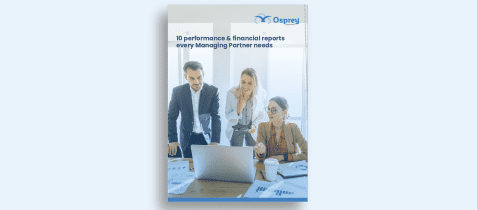Contents
A guide to legal software implementation: How to simplify data migration
Just like your employees, the client, case, and financial data your firm stores is an invaluable asset that you couldn’t be without. It provides crucial insights into the performance of your firm that can help you to better resource, scale, or implement improvements for long-term success. With 34% of SME law firms wanting to become a more data-driven business in 2023, it’s important that the data you hold is accessible.

The importance of your data makes the data migration processes a crucial step in any legal software implementation. We’ve previously answered the six frequently asked questions regarding legal software implementations. But, in this article we discuss how to successfully migrate your data into a new case management system.
To avoid costly delays or mistakes, we list six steps to help simplify the data migration processes, whilst sharing best practices for cleansing, formatting, and utilising your data.
Six steps to simplify your law firm’s data migration
1. Document all your assets and cleanse the data
We recommend, before the data migration and implementation process begins, reviewing and cleansing the data you store. Start by reviewing what you currently hold and create an inventory of your current data assets. Note down the client, case, and financial data fields that you store, regardless of whether it’s up to date, utilised or required. This will provide a starting point for knowing what you don’t need, what is essential, and what you need to start collecting.
For firms who are looking to become more data-driven in their decision making, it’s important your firm is collecting the right data; that it holds information that’ll help you improve, optimise, and achieve your goals. The software’s reporting tools are only as effective as the data that is initially inputted, so this step will reap benefits months down the line.
Once you know what you currently store, start by filtering out and cleansing meaningless data, such as users who no longer work for you or duplicated client information. It’s important to cleanse the data at the start as it’ll help to communicate your database size to your chosen supplier so costs and timescales can be predicted accurately.
2. Document all your assets and cleanse the data
As part of the reviewing and cleansing data process, we also recommend you prioritise your data. This means, decide what data your firm no longer needs to collect, what is essential and required, and what you’d like to start collecting to help you make better data-driven decisions.
To help you decide what is needed, you’ll need to align your data strategy with your firm-wide business strategy. Identify what is most relevant for your goals and what you’ll need to collect in order to track progress towards your objectives. You’ll also need to determine what is required for each team or practice area from a case progression point of view, and crucially from a compliance and regulatory perspective. You’ll then need to consider what is required to ensure a quality client service and effective performance tracking for employees.
3. Define timelines and responsibilities
The next step for simplifying the data migration process is effective planning. At the start of all software implementation projects, you should meet with your assigned project manager to discuss the project, what’s expected, and timelines. This enables deadlines and responsibilities to be assigned to help keep tasks on track.
Within your implementation plan will be dates and plans for the data migration. This will help you allocate resource internally for collecting the right data, sharing samples, testing uploads, and training on the system.
Depending on the size and complexity of your firm and database, it maybe recommended that you review your data in batches. Your project manager can also help to organise the data in the correct formats ready for migration.
4. Provide sample data and test
With years of experience, your software partner will be able to provide advice and guidance on successfully migrating your software, the formats it needs to be in, and the data that’s most important.
Your partner will likely ask for a sample piece of data to understand what you currently hold, and what you plan to migrate. They’ll then be able to advise how to convert the data to the format of the new system. A test upload of your sample data into a training database can help to mitigate any errors and demonstrate how the data will be displayed. This is great preparation for the final data migration.
5. Prioritise team communication & training
Simplify your data migration and overall implementation project by ensuring consistent communication with your employees and thorough training for confident users.
During the cleansing data stage, it’s important to consult department managers to outline what data they require and their wish list. To help align your data strategy, keep the communication frequent on what data has been agreed, what the plans are for the future, how the project is going, and planned timelines. This helps to reduce tension and the unknown, so employees feel prepared and part of the project.
To improve the confidence of your team, training is necessary. Your software partner will provide a thorough training programme to ensure users are aware of the basics and fundamentals to effectively use the system from go live. But it’s important to make use of the ongoing training and ensure it’s prioritised for employees to get the most from the system. We’d also recommend holding internal training sessions on what’s expected when it comes to data collection and storage. Set standards for cleansing the data regularly and communicate what needs to be captured and when. This will ensure your firm collects the relevant data that helps make more informed, data-driven decisions for the business.
6. Utilise your data to make data-driven decisions
Migrating to a new legal software solution is a great opportunity to cleanse your data, review your data strategy, and start a fresh. If you’ve successfully completed stages one to five, then it’s important to utilise the data you now store to impact your business decisions.
Your software solution should include a library of report templates, a report writer, and interactive dashboards that’ll help you export and analyse data. View real-time data to monitor your firm’s performance and implement continuous improvements. And schedule monthly reports to your management team to ensure everyone is on the same page and has access to the data they need to optimise and perform at their best.
As your business goals develop, it’s important to regularly review your data strategy to ensure the information you hold is accurate, and that you’re collecting the data you need to operate effectively.
Streamline the data migration process for your law firm
cleanse your data and create an effective data strategy that aligns with your firm’s objectives. In the long-term, this will ensure your initial data migration is a success, but will also future-proof your firm enabling you to make accurate data-driven decisions.
Simplify your implementation and data migration process further by ensuring effective communication and employee training to ensure the data you store is utilised and users are confident on the system.
Book a consultation with Osprey today to learn more about our implementation service and future-proof your firm through with an all-in-one cloud-based case management system.
For more information on implementing legal software at your law firm, check out all parts of our legal implementation guide:
Part 1 – 6 implementation FAQs answered
Part 2 – 7 factors that impact the length of software implementation
Part 4 – How much does legal software cost?
Part 5 – How to effectively train your staff




